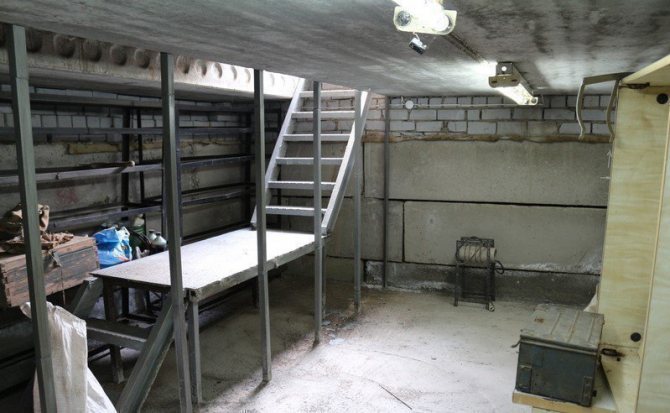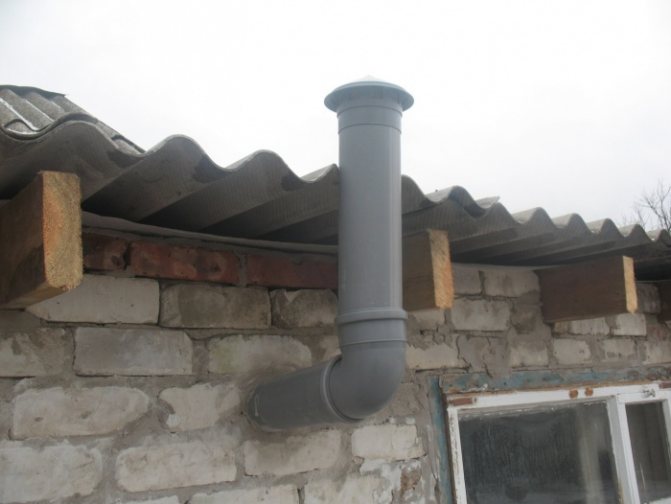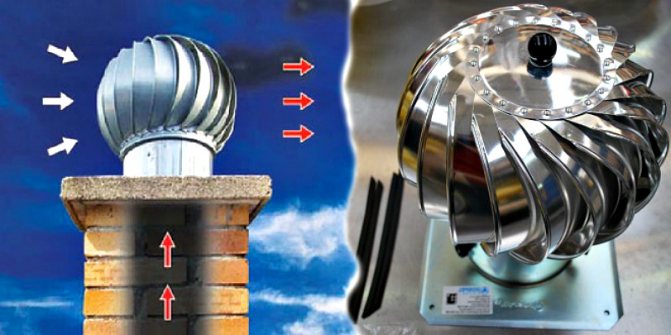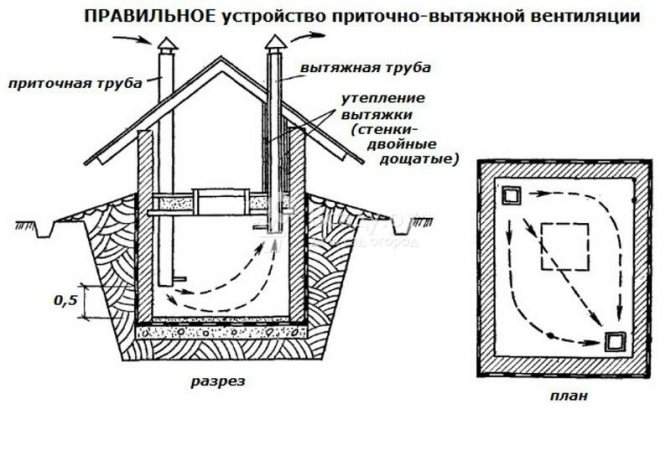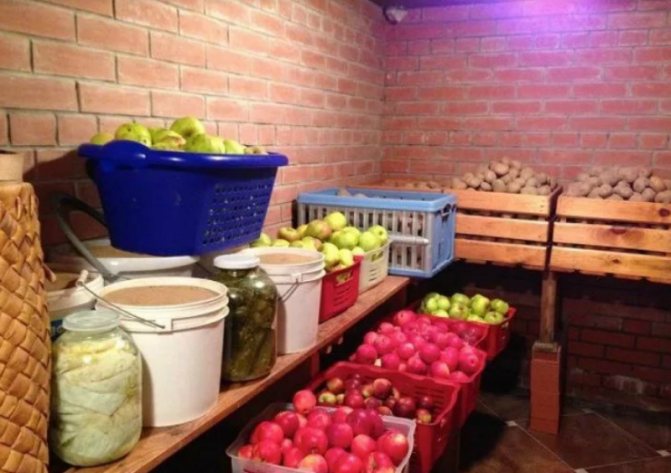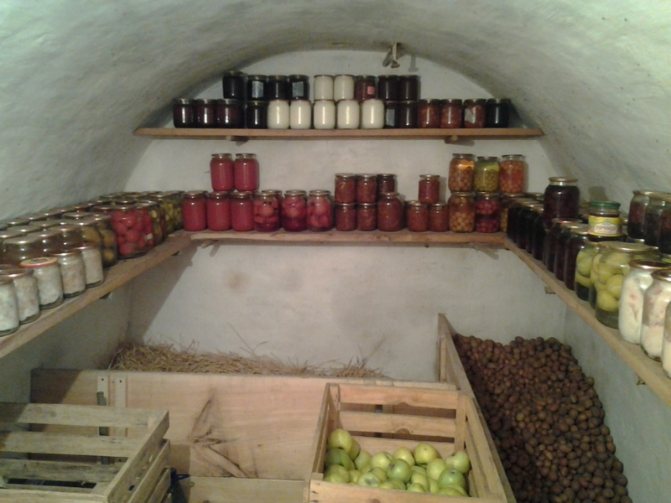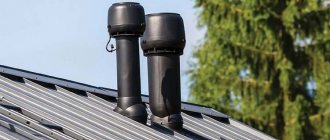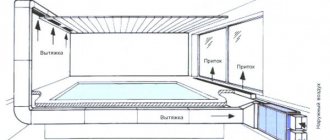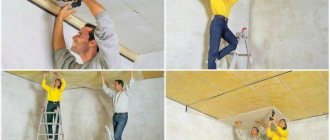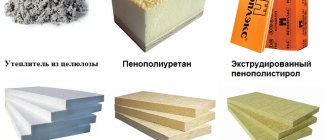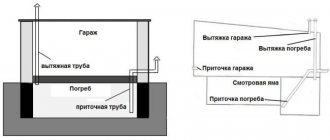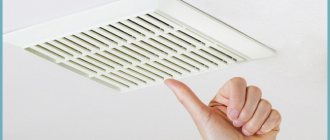The arrangement of high-quality ventilation in the cellar in the garage contributes to the formation of a healthy indoor climate. Correct air exchange allows you to store vegetables, fruits or canned food almost all year round. The constant change of air prevents the formation of dampness and, as a result, fungi and mold. Otherwise, the products will deteriorate rather quickly, and the resulting moisture can not only destroy the cellar over time, but also harm the car in the garage.
The cellar requires the arrangement of high-quality ventilation
Selecting the type of ventilation
For a normal healthy microclimate, a sufficient amount of air must enter the cellar. Its inflow can be ensured in two ways:
- arrangement of natural ventilation;
- the creation of a forced draft mechanism.
Natural ventilation works on the principle of thermal convection. The drier air coming from the street sinks to the very bottom of the basement, and then, having warmed up, rises up, freeing up space for a new portion of fresh air.
Forced ventilation on the principle of arrangement is very similar to natural, but only when it is assembled, additional electrical mechanisms are used to facilitate faster air movement. The blowers used provide a more efficient ventilation system.
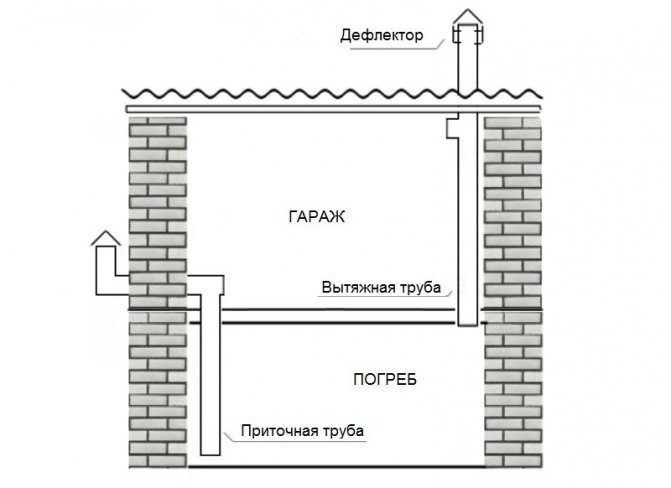
Supply and exhaust ventilation scheme in the cellar
Installation diagram
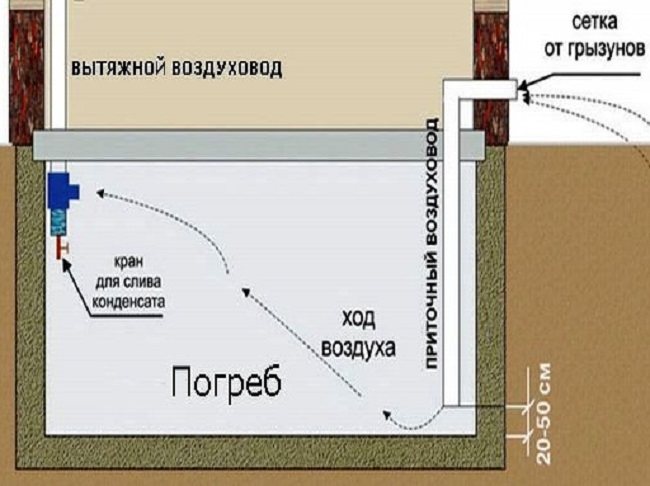

Supply and exhaust ventilation scheme
- A visor is installed at the end of the exhaust duct.
- To ensure proper ventilation, the top end of the exhaust duct must be positioned higher above ground level.
- The radius of the ducts must be the same.
- When calculating the diameter of the pipe, you need to use the formula: for every 1 m3 of the cellar located below ground level, there should be 20 cm2 of the diameter of the ventilation pipe.
This approach is used for both natural ventilation and forced ventilation. In order to properly install the ventilation, you must first make a calculation, namely, to establish the area of the cellar and the rate of air consumption. This ensures correct air exchange and will allow in the future to completely renew the air in the cellar every 30 minutes. This level of circulation can be achieved by laying 25 cm of a canal for every 1 m2 of space.
Important! After installing any type of ventilation, there should be no extra holes in the pipes through which air will penetrate into the room. Slots significantly reduce ventilation, so damp air can enter the garage. Therefore, condensation can settle on vehicle parts, which is highly undesirable.
In principle, the ventilation device in the cellar is a job that a homeowner can do on his own with great desire and ordinary non-professional tools. Start with the design - elementary schematic drawings, material calculations, determination of the features of the ventilation system operation under various temperature conditions.
The choice of pipes for arranging ventilation
As the basis for the entire ventilation system in the cellar in the garage, you can use pipes made of almost any material:
- metal;
- asbestos;
- plastic;
- from aluminum and others.
Other pipe options are also suitable, for example, made of cast iron, but their use is often impractical due to the higher cost. Usually, air ducts with a diameter of 110 to 200 mm are used.
Both air ducts providing ventilation in the cellar in the garage must be equipped with dampers. Their task is to partially or completely block the movement of air. This may be required in cold weather.
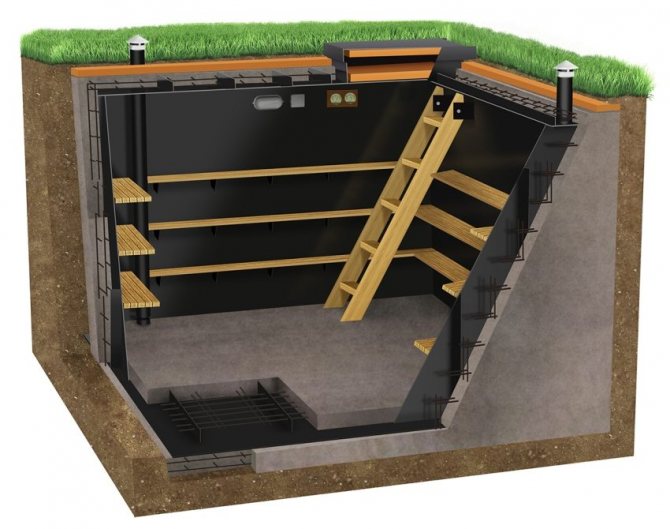

Arrangement of a cellar with ventilation, reinforced base walls and floors and an insulated ceiling
Winter air exchange
Ventilation of the cellar in the garage in winter has its own characteristics and prerequisites that must be observed. The efficiency of the natural ventilation system in the basement of the garage is significantly reduced in the summer. This is due to the fact that the hood cannot efficiently remove air due to the equalization of the outside and inside temperatures. In winter, other problems arise:
- snow covers the inlets of the air ducts;
- icing and blockage of pipes is formed.
For this reason, in winter, natural ventilation must be periodically inspected, excess snow removed from the roof, and pipes must be heated if necessary.
If the air duct is led outside the walls of the garage, it must be additionally insulated. For this, a system with double pipes of various diameters is perfect, where insulation is laid between them.
A method of wrapping the pipe with insulation or sealing it in a special box is also suitable. If the pipes are located inside the garage, then it is worth sealing and insulating the places where the pipes exit on the roof and from the walls.
Arrangement of natural ventilation in the cellar in the garage
This system consists of only two pipes. One of them is responsible for the supply of fresh, dry air, and the second for the removal of waste, by bringing it out. The most advantageous places for laying pipes are the opposite corners of the cellar. With this arrangement, the likelihood of the formation of places in which the air will stagnate is significantly reduced.
The supply pipe should be lowered to approximately 0.4-0.5 m from the floor, while the exhaust pipe should be down to 1.5-2 m. The exhaust duct should be longer than 2.5 m in order to ensure a sufficient temperature difference to facilitate movement air. A special deflector is installed on its upper part, towering over the roof. It will perfectly protect the basement from dust and precipitation, and will also take care of a more efficient extraction.
The supply part of the duct is positioned in such a way that its upper part is about half a meter from the ground. A fine-mesh lattice is additionally installed on it, which will protect against the penetration of any living creatures into the cellar: rats, mice, cats.
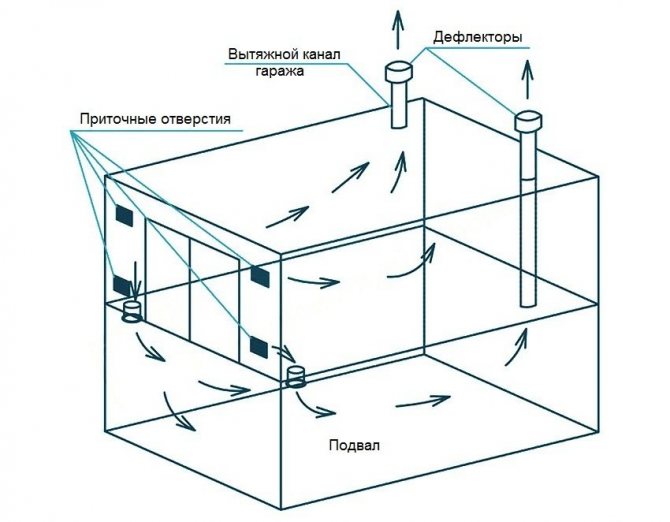

The scheme of natural ventilation in the garage, under which the basement is located
Ventilation in a private house
Winter time slightly changes the nature of the circulation of air flows inside a private house. As the outside air gets colder, the difference in pressure between the air masses increases, and the thrust increases. The warm exhaust air flow is removed faster due to the fact that the supply cold air flows inside in a larger amount. Together with the displaced air, the heat of the heating equipment is released, which did not have time to sufficiently warm the room. This increases energy consumption by 25-30% on average.
Supply ventilation through wall, window valves in severe frosts can supply a cold air flow, creating discomfort. If the ventilators inside the window are not regulated, then the diffusers of the wall valves allow you to restrict the inflow or temporarily close it. A good option is to place such valves above the heating radiators, since the inflow will immediately be heated by the heat of the heating equipment.
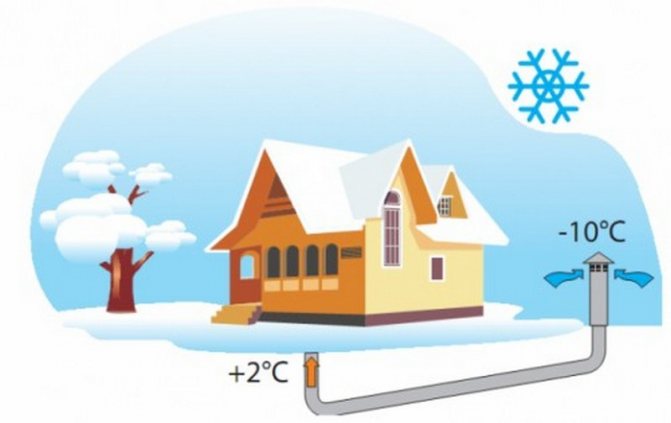

By automating the air exchange system, you can reduce heating costs while maintaining the quality of room ventilation. Supply and exhaust ventilation with heat recovery is considered the most effective.The recuperator heats up the incoming air flow due to the heat of the air removed to the outside. At the same time, cold air masses warm up to + 12 + С.
Also energy efficient in winter is a ground heat exchanger, which heats the supply air with the warmth of the soil. Air ducts (about 15 m long) are installed at a depth of at least 1.5 m, where the soil does not freeze. When passing through the heat exchanger, the air has time to warm up to a positive temperature. This saves 20-25% of the energy allocated for heating a private house.
Forced ventilation
The design of forced ventilation in the cellar in the garage is practically the same as with natural air exchange, only it is additionally equipped with fans powered by the network. That is why it is necessary to follow the basic rules of electrical safety, because the condensate accumulated in the pipes can cause a short circuit. You need to purchase equipment that can work in wet conditions and be sure to perform high-quality waterproofing.
The fans can only be installed in one pipe. This is usually done in an exhaust duct. If you put the blower in the supply pipe, the ventilation efficiency in the cellar in the garage will be much higher. Another advantage of mechanical ventilation is the independence of the system from weather conditions. In any case, the room will dry out quickly and it will not be difficult to maintain the necessary humidity in it.
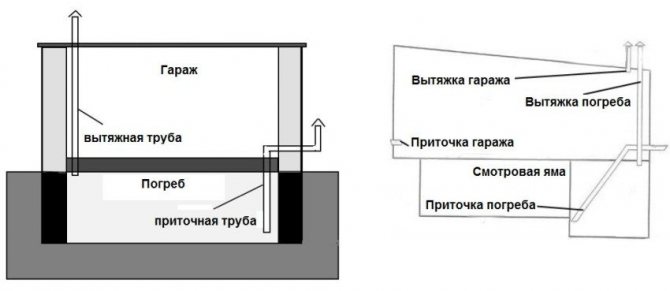

Cellar ventilation options with one or two exhaust pipes
Supply ventilation can be organized not only with a fan. Can be used:
- Diffuser-vane. It is installed on the upper end of the supply air duct. This design works due to wind energy.
- Low power light bulb - minion. It improves the quality of air exchange by heating the streams.
It is also possible to create an automatic system that will work independently, with little or no external control. Such ventilation structures are equipped with special sensors that will independently turn on the supply and exhaust mechanisms when the air parameters change: humidity, temperature. Such systems also turn off on their own when all indicators are normalized.
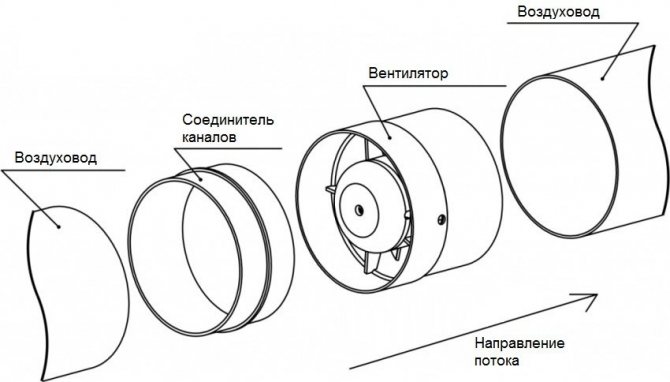

Duct fan assembly diagram
Ventilation of the garage in winter
A garage is a building, the ventilation of which cannot be stopped in winter. There are several reasons for this:
- In winter, more than usual, a lot of moisture remains on the car (snow, ice, mud). In the garage, snow, ice melt, moisture evaporates. With sufficient ventilation, the car body dries faster. If there is little or no ventilation at all, corrosive processes can begin.
- In addition, excess air humidity negatively affects the structure itself. The metal garage structure will quickly rust, the brick building will also deteriorate over time, and mold will appear.
- Exhaust gases, chemical vapors must be removed by the ventilation system to the outside. Otherwise, it will negatively affect the health of the car owner. If a cellar is located under the garage, harmful substances will enter it, poisoning the products stored there.
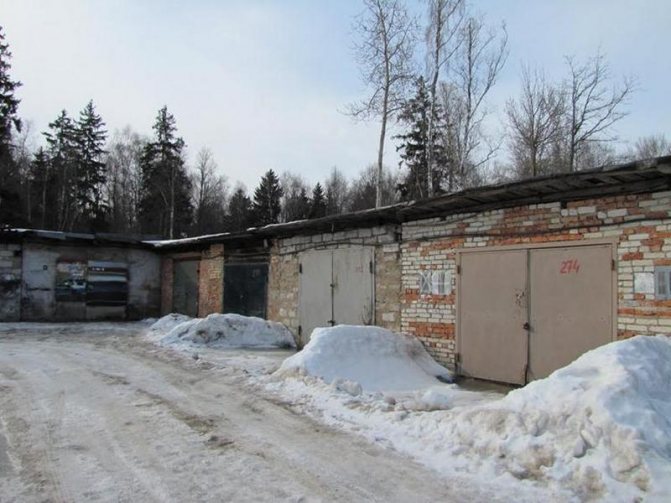

How to make ventilation in the garage with your own hands? Simple and easy! >>>
In a small garage, it is enough to organize natural ventilation by equipping it with supply and exhaust ducts. It can be improved with fans, which will increase the circulation of air flows. In winter, the air draft is quite strong due to the large temperature difference inside the garage and outside. The dampers installed inside the ventilation pipes will help to regulate the flows.
Also, if possible, in winter, the garage room should be heated with heating devices in order to dry it, remove excess moisture from the melted snow, improve the recirculation of air flows inside the garage, inspection pit, and basement.
It should be remembered that when ventilating the inspection pit, the car must not be parked at the outlet of the exhaust air from it. The exhaust air flow, especially in winter, is more humid; with prolonged contact with it, the body metal will corrode.
When is natural ventilation not enough?
An organized natural ventilation system may not be enough in the following cases:
- Large cellar area (more than 40 m2). In this case, during the frosty season, the chimney can be completely covered with frost formed due to frozen condensate. As a result, air movement is significantly reduced and becomes insufficient to organize the correct microclimate. If a basement with such an area is divided into separate rooms and pipes are installed in each, then mechanical ventilation will not be needed.
- Natural air exchange will not be enough if it is planned to equip a workshop or a mini-gym in the garage cellar. Only fans can supply enough oxygen.
- Air movement with blowers will be required if you plan to store a large amount of supplies. If vegetables are stored in the cellar, then the exhaust device will still fight against unpleasant odors.
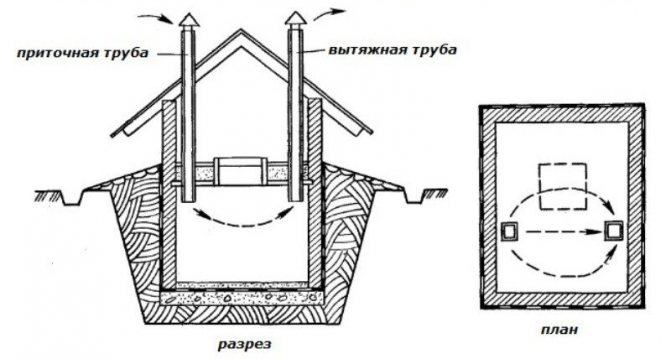

Example wrong ventilation devices (pipes are on the same level and are not equipped with valves)
Cellar ventilation in winter: operating rules
Ventilation of a cellar or basement, as well as any engineering communications, requires competent maintenance and operation. On the eve of winter, the ventilation pipes should be insulated by wrapping them with mineral wool or any insulation. On top of which to wrap with waterproofing. This will exclude the formation of frost on the chimney or freezing of condensate in frosty weather. And it will provide full ventilation. Now the trade offers polystyrene foam for pipe insulation, a modern insulation material that is very easy to install.
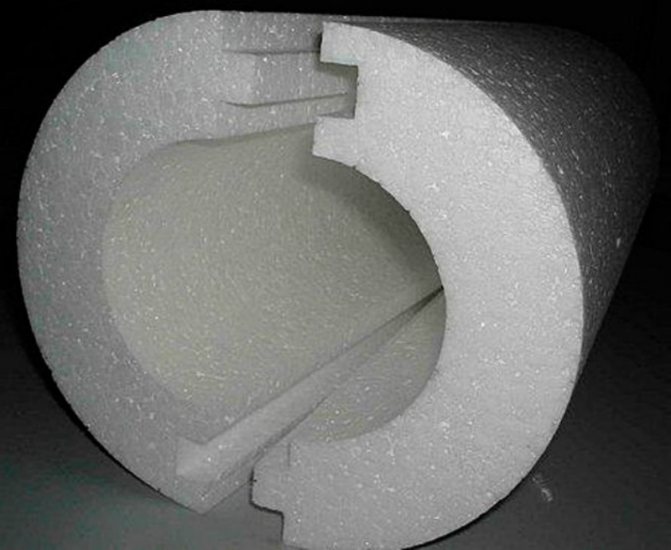

In winter, when frosty weather sets in, the influx of cold air can cool the cellar very quickly. Even down to subzero temperatures. But in this case, the dampers on the ventilation pipes will come to the rescue. Covering the dampers, primarily on the supply ventilation duct, it is possible to regulate the flow of frosty air from the outside. And even completely block off for the time of very severe cold weather.
In winter, the owner of the cellar will have to determine the level of necessary ventilation, depending on the weather and climatic conditions. And arrange it in a metered fashion, closing or opening the valves.
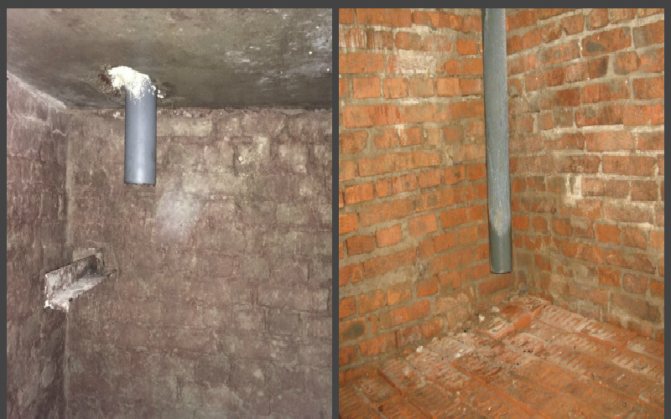

Ventilation system control
The quality of ventilation in the cellar in the garage, as well as its performance, is recommended to be periodically checked. To do this, go down to the cellar and light a match. If the flame goes out quickly, then there is a large amount of carbon dioxide in the room, therefore, the air exchange is rather weak.
The ventilation system in the cellar in the garage requires periodic inspection and cleaning of accumulated dirt and debris. It is periodically overgrown with cobwebs, layers of dust. The mechanical part of the structure also needs to be checked. For more efficient operation and control of the amount of incoming air, one supply channel is divided into two parts using a special partition. Thus, it is possible to normalize the volume of incoming air.
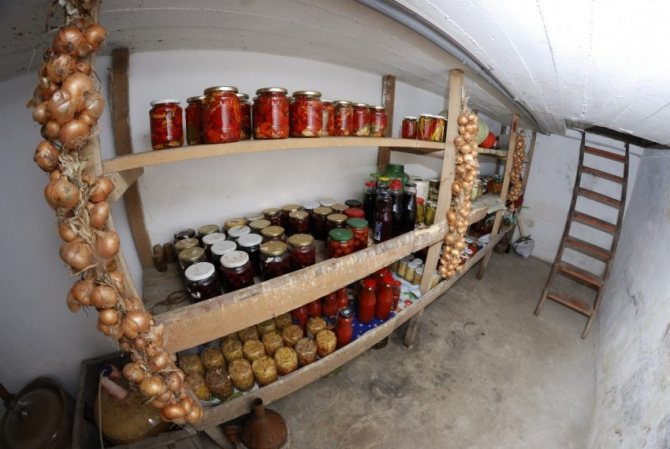

Cellar under the garage
Topically about the cellar
For some reason, in central Russia, it is customary very early, already in October, to tightly close the cellar. At this time, the cellar is still very warm: + 8 ... + 12 degrees. At such high temperatures, potatoes and root vegetables begin to grow. Pathogenic fungi and the beginnings of phytophthora also wake up.The potatoes may start to rot.
For food to be well preserved, the temperature in the cellar should be within -3 ... -4 degrees, not higher. I believe that the cellar should be tightly closed only with the establishment of stable negative temperatures, when the temperature in the cellar drops to + one degree. And this happens in our area in December.
For example, today is December 20, my cellar is still closed only with a plank cover and is not insulated in any way. Naturally, in order to be calm about the temperature in the cellar, first of all, you need to lower the thermometer into the cellar and put the potatoes on the pile. I finally close and insulate my cellar in the shed for the winter with an old mattress, about December 15-25, only then the thermometer in the cellar shows 0 degrees. This happens when it will be -10 ... -20 degrees outside. After the cellar is closed, due to the heat reserve in the pile of potatoes, literally in 2-3 hours the temperature in the cellar rises to + 2 ... + 3 degrees. After all, I repeat, all the troubles are that food deteriorates in the cellar, root crops sprout, stem from the fact that the temperature there becomes higher than + 3 ... + 4 degrees. At this temperature, the activity of all pathogens, including putrefactive fungi, increases.
To avoid excessive dampness in the cellar, it is imperative to provide for pull-out ventilation. These are two pipes (supply and exhaust), 8-10 cm in diameter. The lower end of the supply pipe is installed half a meter from the cellar floor, and the exhaust pipe is installed directly at the ceiling. It is advisable to place these pipes in the opposite, diagonally, corners of the cellar. Without this, ventilation will not work well.
In winter, when I take out the necessary products, I check the temperature with a thermometer and, if the temperature rises to + 5 ... +6 degrees, I cool the cellar, leaving the hole open until the temperature drops to 0 ... + 1 degrees. This can take 18-24 hours. When I close the cellar and re-insulate the manhole cover, the temperature, due to the heat in the thickness of the pile of potatoes, will quickly rise to the optimum, that is, up to + 2 ... + 3 degrees. It is necessary to cool and ventilate the cellar up to 3-4 times during the winter.
In the spring, while it is still cold outside, I again lower the temperature to 0 degrees and close it tightly so that there is a thermos effect and the summer heat does not enter the cellar. However, despite this, sometimes in the summer the cellar has to be cooled artificially. To do this, I put 5-6 plastic 1.5-2.0 liter bottles of water in the freezer of the refrigerator. When the water freezes, I keep it in the freezer for another day, since the water freezes at a temperature of 0 degrees, and only after a day it will take the temperature of the freezer: -12, -18, or -24 degrees, depending on the type of freezer. Then I put the bottles on the floor of the cellar and also close the hole tightly. The bottled water gradually melts, the temperature in the cellar drops. I repeat the procedure if necessary.
Installation of the ventilation system: the main stages
When installing the ventilation system, a large number of tools are not required. You will need:
- the pipes themselves;
- fastening clamps;
- screws and dowels;
- grilles for protection;
- deflectors or visors;
- drill and hammer.


Air is removed through the exhaust duct, the inlet opening of which is located opposite the gate
Holes are punched in the walls for fastening pipes, fasteners are installed. The duct sections are assembled on the floor, after which the finished structure is fixed in the prepared fixings. All joints must be sealed with special tape or sealant.
The process of arranging ventilation in the cellar in the garage, as you can see, is simple. The best option is considered to be a system created at the construction stage. But if there is none, then it will not be difficult to assemble the entire structure yourself.
When to open vents
Vents, or as they are also called air vents, serve to ventilate the cellar or underground in the house, bathhouse, shed and other buildings. With daily and seasonal temperature drops, condensation accumulates in the basement, mainly on the upper elements of the subfloor, that is, on the ceilings. Good ventilation of the foundation through uncovered vents prevents condensation from accumulating in the subfloor.
Before opening the vents, read how to make the correct vents in the foundation. If there are not enough air vents in the subfield, then the opening time of the vents must also be shifted.
The vents are kept open from the beginning of the spring heat, when the average daily temperature becomes above zero and until the autumn cold weather, when the average daily temperature crosses the zero mark in the negative direction. This ventilation mode through vents in the foundation of a house, bath, shed and other buildings will provide a minimum amount of moisture in the basement. In the Moscow region, the period with an average daily temperature below zero lasts about 130 days. If you start from the air temperature, you usually need to close the vents in mid-November, and open the vents in the second half of March.
There is also a popular sign that the vents need to be closed on the day of the church holiday, the Protection of the Most Holy Theotokos, or the Protection of the Day. It falls on October 1.
It is believed that there is no need to close the vents in the house at all, which will ensure year-round ventilation of the cellar. In unheated buildings, this option is suitable, but in residential buildings, baths and heated buildings, open vents will remove not only moisture, but also heat from the underground. With this ventilation mode of the foundation, no matter how you heat the room, the floors will still be cold, and in severe frosts, freezing of the floors is generally possible!
You can close the vents with foam rubber, insulation, old rags. With a hole diameter of 110 mm, sewer pipe plugs can be adapted to close the vents. There are also various grids on sale that can be used to adjust the size of the hole in the vent.
Let's summarize the above. It is necessary to close the vents in the house for the winter, but the main thing is to seize the moment so that the floor in the house remains warm and the underground dry. The vents can be opened with the onset of a climatic spring, that is, with the arrival of heat.
Would you like to know if the underground floor in your house is well ventilated? Read on for how to make foundation vents correctly.
Rules for the construction of ventilation ducts
There are certain recommendations for installing ventilation pipes in the cellar:
- The ventilation pipes should be on opposite sides of the cellar. Ventilation will not work properly if pipes are placed next to each other. It turns out that the freshly supplied air after a while, without "walking" in the cellar, leaves through the chimney.
- The supply and exhaust pipes should have approximately the same radius. Ventilation will simply be impossible if the chimney has a smaller radius (in winter, the temperature in the cellar will begin to drop below zero, and in summer, on the contrary, rise to critical values for the storage).
- If possible, the pipes should not be bent at all. Ventilation will be difficult if there are many bends. And this will negatively affect the indoor microclimate in winter.
- The supply duct should be located at a distance of 20-30 cm from the floor. This is necessary in order for fresh air to enter the lower part of the room. It is recommended to close the upper end of the pipe with a metal mesh and a cap, which in summer will prevent rodents and insects from entering the room, and in winter - snow.
- The lower end of the exhaust duct must be positioned directly under the cellar ceiling. Again, the laws of physics play a role here, because warm air will accumulate in large quantities just under the ceiling.The top of the pipe must be above the roof of the building, and the exit must be protected with a cap to prevent rain and snow from entering the pipe.
- To be able to control the air exchange in the cellar, it is recommended to equip the pipes with dampers. It is worth noting that the dampers play an important role precisely in the winter, when their use will help to comply with the conditions necessary for storing the crop.
It should be borne in mind that only warm air will escape through the exhaust duct. That is why quite a lot of condensate droplets will appear in the pipe during the winter months. These droplets, under the influence of negative temperatures, will soon begin to freeze, as a result of which the chimney will be completely clogged.
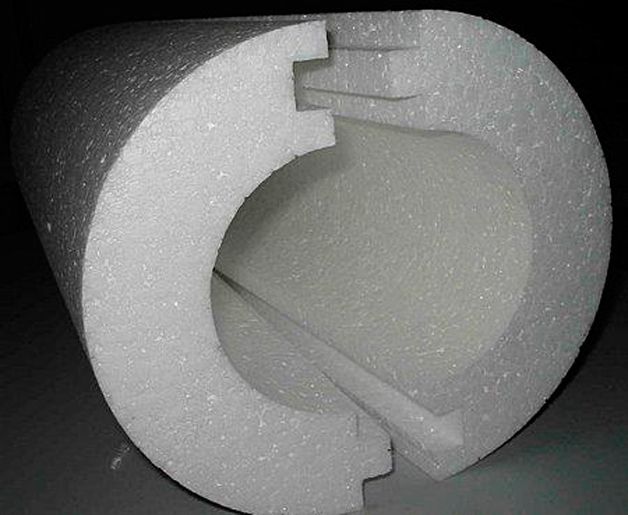

Insulation for pipes - expanded polystyrene.
To avoid such problems, the exhaust duct must be well protected from the effects of negative temperatures. In other words, it is recommended to insulate the entire pipe using modern heat-insulating materials. It is important that the heat insulator is resistant to constant exposure to moisture, in addition, the entire structure must be systematically cleaned from frost and snow. Ideally, you have a removable outlet for the exhaust duct.
If you have installed natural ventilation, then there are no problems during the operation of the cellar in winter: air exchange (unless, of course, the channels are blocked) will be carried out in full, no maintenance (except for cleaning the pipe) will be required. But difficulties will lie in wait for you during the warmer months, when the outside temperature rises higher than in the cellar. The only salvation in this case is a forced ventilation device.
Features of air exchange in the cellar in winter
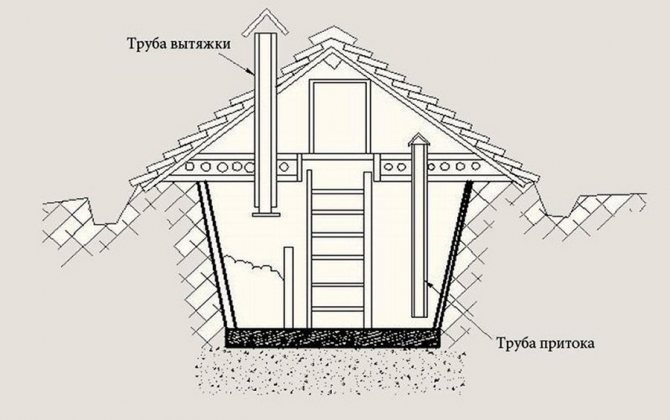

Usually, air exchange in the cellar is carried out thanks to several pipes. For a small room, just one is often enough.
The pipes must be equipped with special valves - thanks to them, it is possible to monitor the operation of the system.
The ventilation in the cellar in winter requires special care. It is highly desirable to insulate the air duct before the onset of cold weather (mineral wool or expanded polystyrene is ideal as a heater), and also provide at least minimal waterproofing so that water does not penetrate into the cellar. All this will allow the system to work and perform its function without failures.
It should be borne in mind that at low temperatures the air circulates at a higher speed. This means that the temperature in the cellar will drop faster.
Therefore, it is advisable to regulate the level of air intake in advance, if in the weather forecasts - the onset of frost.
Even if the entire system was very well insulated, this does not give a 100% guarantee that there will be no frost or frozen water on it. This can significantly impair the circulation of air currents.
Therefore, in winter, it is important to inspect the air ducts and clean them at regular intervals. To facilitate the process, you can make the most problematic areas removable.

